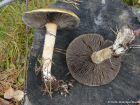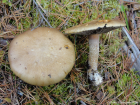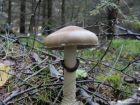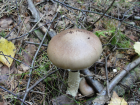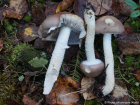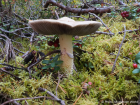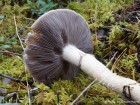Cap convex to broadly conic as young, sticky, and ranges in colour from reddish-brown to violet-brown or brown. As it matures, the cap becomes broadly convex, nearly flat, or broadly bell-shaped, and it usually fades to tan or pale yellowish brown. The cap is bald, occasionally showing slight radial streaks, and often has white veil remnants near the margin. Gills fairly crowded, initially adnate (broadly attached to the stem) but may be slightly detaching with age. Initially pale grey, they later turn purplish grey to purple-black. Stem more or less equal with a persistent white ring, grooved on the upper surface and dusted with purple-black spore dust. Below the ring, it appears shaggy-scaly with whitish girdles, particularly when young. Spore print purple brown.
Microscopic Features: Spores are smooth, ellipsoidal, measuring 11-13 x 6-6.5μm, and do not have a germ pore.
Stropharia hornemannii on the first-nature.com Web site.
Stropharia hornemannii on the MushroomExpert.Com Web site.
Many mushrooms are poisonous, and some can be lethally toxic. Distinguishing between edible and poisonous mushrooms can be very challenging. Therefore, we strongly advise against consuming wild mushrooms. This website does not contain any information about the edibility or toxicity of mushrooms.
Although efforts have been made to ensure accuracy on this website, the information may contain errors and omissions. Therefore, all content provided is for educational and informational purposes only and should not be relied upon or used as a basis for consuming any plants or mushrooms.
External links are provided for reference only. We do not endorse or take responsibility for the content, advice, or products found on these sites or in any advertisements shown on this website.
